Taxation Law
VerifiedAdded on 2023/03/23
|9
|2462
|83
AI Summary
This document provides answers to various scenarios related to taxation law. It discusses the CGT consequences of selling antique objects, the treatment of income from personal exertion, and the inclusion of loan repayments in assessable income. It also references relevant case law.
Contribute Materials
Your contribution can guide someone’s learning journey. Share your
documents today.
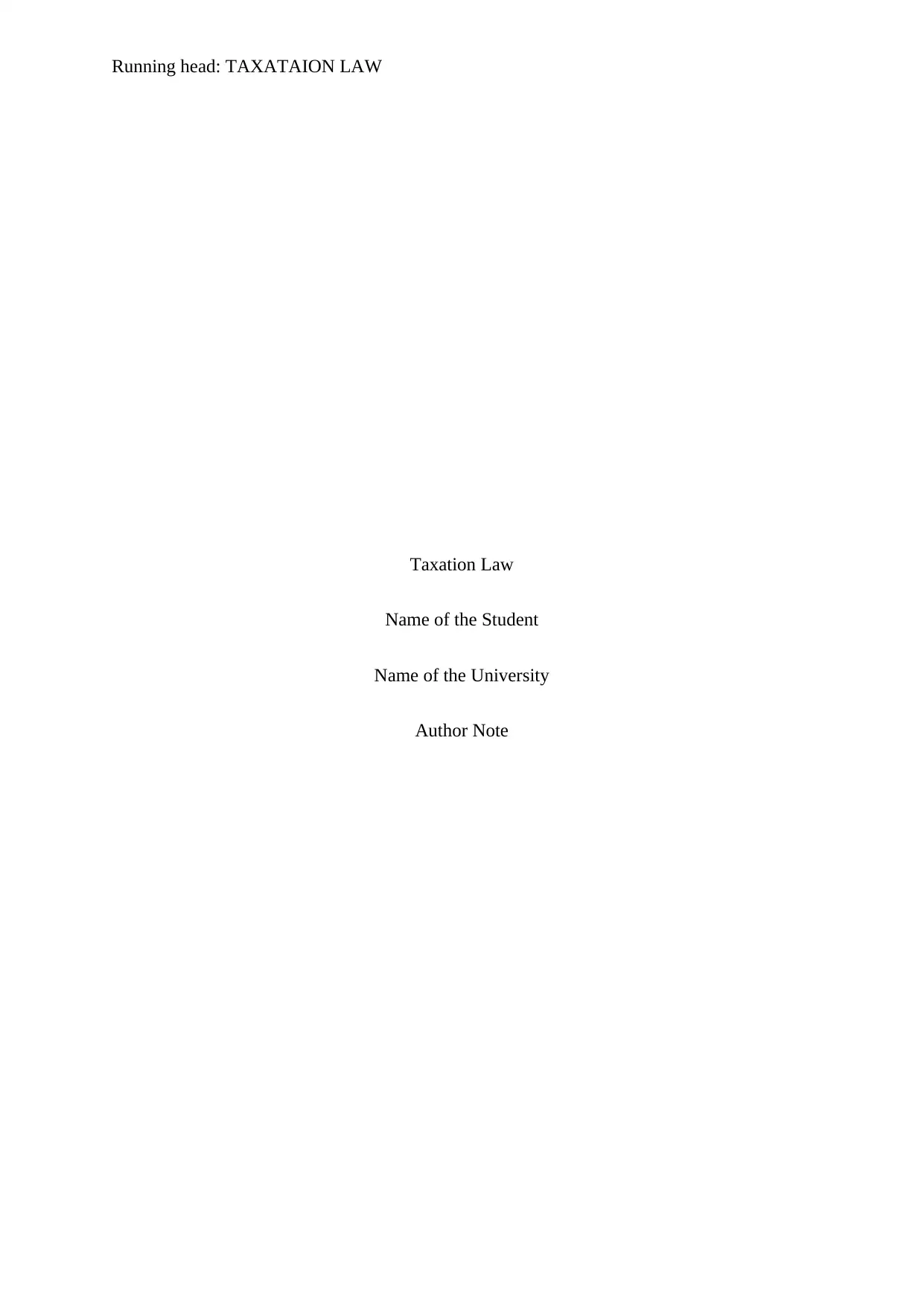
Running head: TAXATAION LAW
Taxation Law
Name of the Student
Name of the University
Author Note
Taxation Law
Name of the Student
Name of the University
Author Note
Secure Best Marks with AI Grader
Need help grading? Try our AI Grader for instant feedback on your assignments.
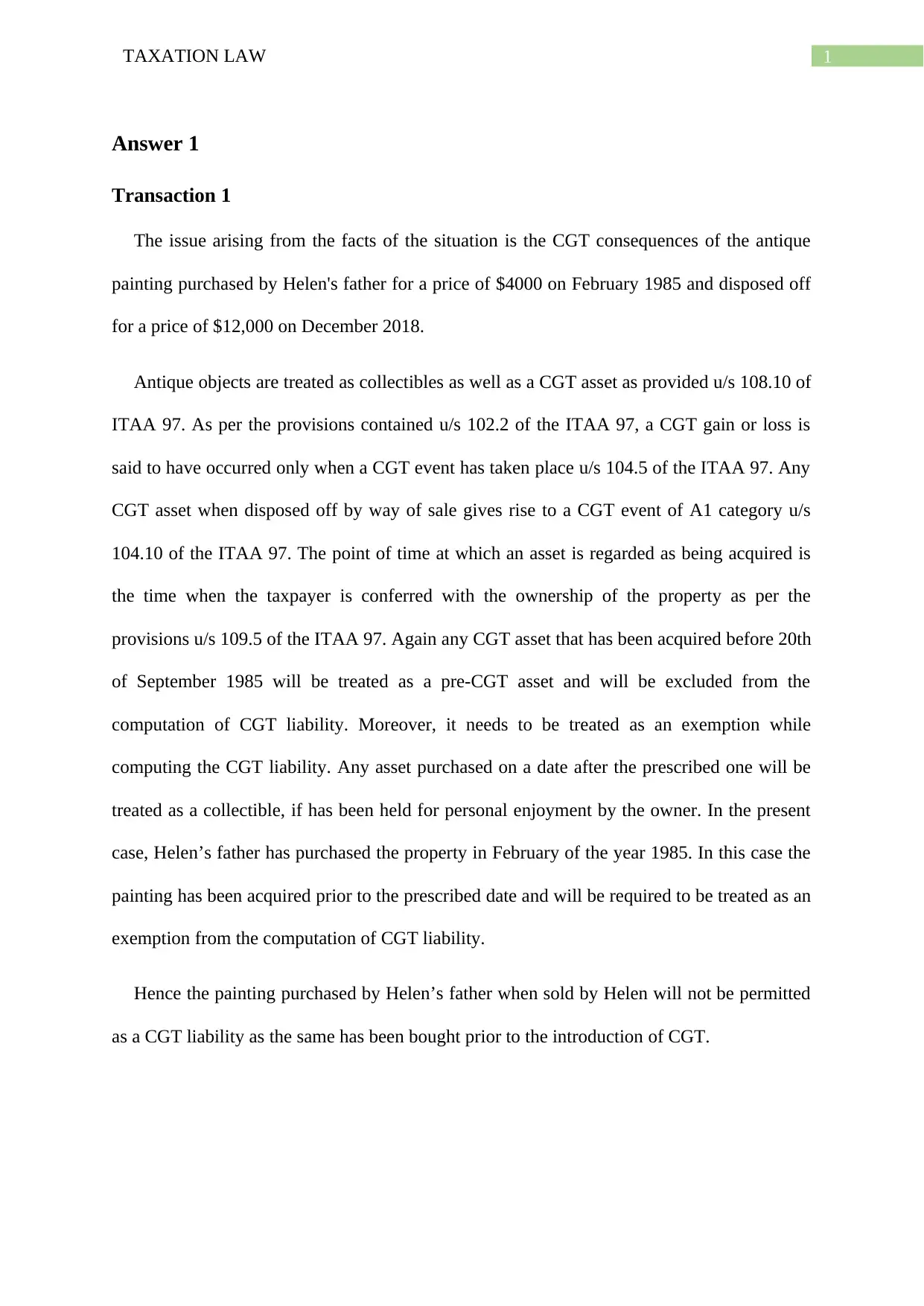
1TAXATION LAW
Answer 1
Transaction 1
The issue arising from the facts of the situation is the CGT consequences of the antique
painting purchased by Helen's father for a price of $4000 on February 1985 and disposed off
for a price of $12,000 on December 2018.
Antique objects are treated as collectibles as well as a CGT asset as provided u/s 108.10 of
ITAA 97. As per the provisions contained u/s 102.2 of the ITAA 97, a CGT gain or loss is
said to have occurred only when a CGT event has taken place u/s 104.5 of the ITAA 97. Any
CGT asset when disposed off by way of sale gives rise to a CGT event of A1 category u/s
104.10 of the ITAA 97. The point of time at which an asset is regarded as being acquired is
the time when the taxpayer is conferred with the ownership of the property as per the
provisions u/s 109.5 of the ITAA 97. Again any CGT asset that has been acquired before 20th
of September 1985 will be treated as a pre-CGT asset and will be excluded from the
computation of CGT liability. Moreover, it needs to be treated as an exemption while
computing the CGT liability. Any asset purchased on a date after the prescribed one will be
treated as a collectible, if has been held for personal enjoyment by the owner. In the present
case, Helen’s father has purchased the property in February of the year 1985. In this case the
painting has been acquired prior to the prescribed date and will be required to be treated as an
exemption from the computation of CGT liability.
Hence the painting purchased by Helen’s father when sold by Helen will not be permitted
as a CGT liability as the same has been bought prior to the introduction of CGT.
Answer 1
Transaction 1
The issue arising from the facts of the situation is the CGT consequences of the antique
painting purchased by Helen's father for a price of $4000 on February 1985 and disposed off
for a price of $12,000 on December 2018.
Antique objects are treated as collectibles as well as a CGT asset as provided u/s 108.10 of
ITAA 97. As per the provisions contained u/s 102.2 of the ITAA 97, a CGT gain or loss is
said to have occurred only when a CGT event has taken place u/s 104.5 of the ITAA 97. Any
CGT asset when disposed off by way of sale gives rise to a CGT event of A1 category u/s
104.10 of the ITAA 97. The point of time at which an asset is regarded as being acquired is
the time when the taxpayer is conferred with the ownership of the property as per the
provisions u/s 109.5 of the ITAA 97. Again any CGT asset that has been acquired before 20th
of September 1985 will be treated as a pre-CGT asset and will be excluded from the
computation of CGT liability. Moreover, it needs to be treated as an exemption while
computing the CGT liability. Any asset purchased on a date after the prescribed one will be
treated as a collectible, if has been held for personal enjoyment by the owner. In the present
case, Helen’s father has purchased the property in February of the year 1985. In this case the
painting has been acquired prior to the prescribed date and will be required to be treated as an
exemption from the computation of CGT liability.
Hence the painting purchased by Helen’s father when sold by Helen will not be permitted
as a CGT liability as the same has been bought prior to the introduction of CGT.
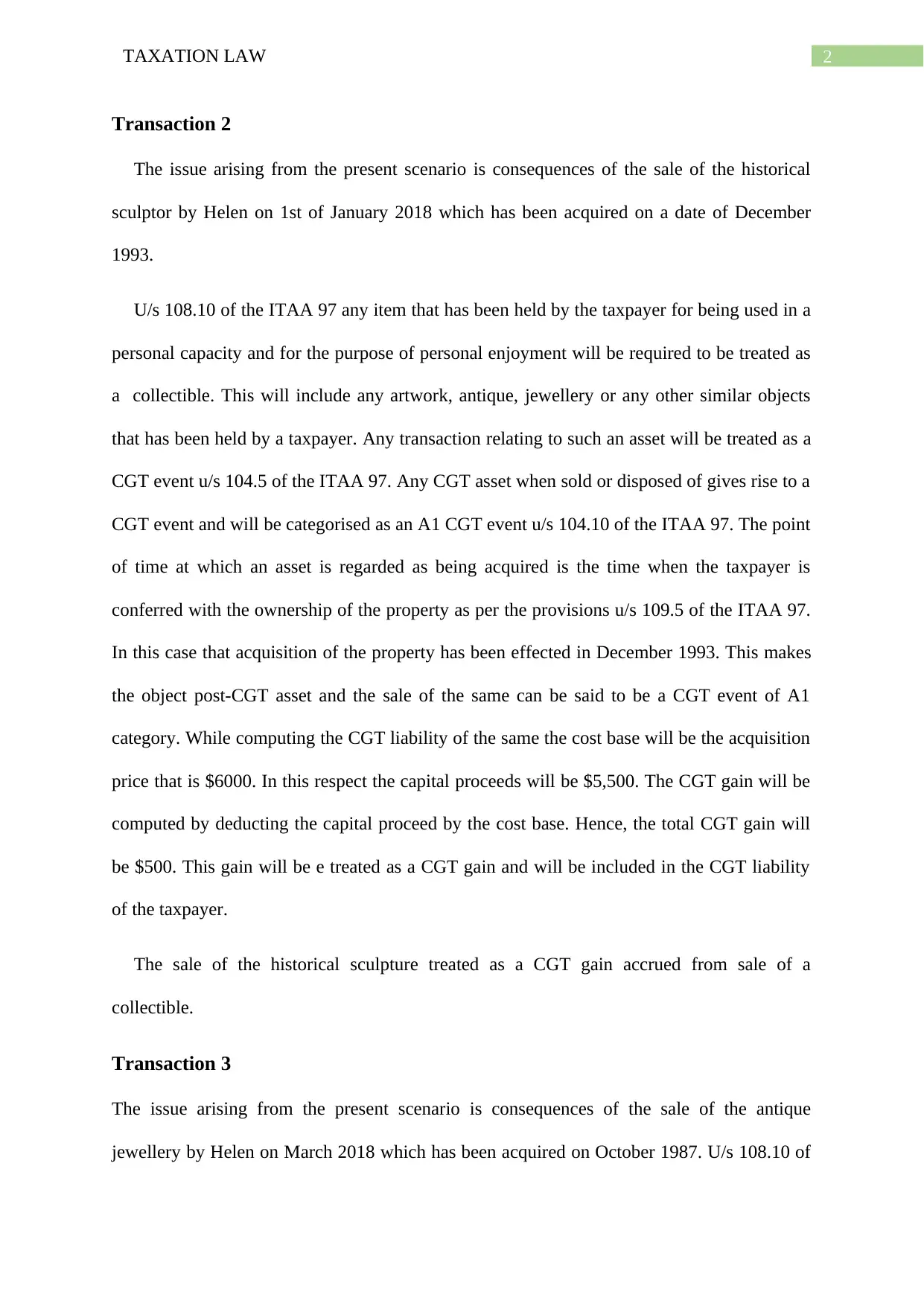
2TAXATION LAW
Transaction 2
The issue arising from the present scenario is consequences of the sale of the historical
sculptor by Helen on 1st of January 2018 which has been acquired on a date of December
1993.
U/s 108.10 of the ITAA 97 any item that has been held by the taxpayer for being used in a
personal capacity and for the purpose of personal enjoyment will be required to be treated as
a collectible. This will include any artwork, antique, jewellery or any other similar objects
that has been held by a taxpayer. Any transaction relating to such an asset will be treated as a
CGT event u/s 104.5 of the ITAA 97. Any CGT asset when sold or disposed of gives rise to a
CGT event and will be categorised as an A1 CGT event u/s 104.10 of the ITAA 97. The point
of time at which an asset is regarded as being acquired is the time when the taxpayer is
conferred with the ownership of the property as per the provisions u/s 109.5 of the ITAA 97.
In this case that acquisition of the property has been effected in December 1993. This makes
the object post-CGT asset and the sale of the same can be said to be a CGT event of A1
category. While computing the CGT liability of the same the cost base will be the acquisition
price that is $6000. In this respect the capital proceeds will be $5,500. The CGT gain will be
computed by deducting the capital proceed by the cost base. Hence, the total CGT gain will
be $500. This gain will be e treated as a CGT gain and will be included in the CGT liability
of the taxpayer.
The sale of the historical sculpture treated as a CGT gain accrued from sale of a
collectible.
Transaction 3
The issue arising from the present scenario is consequences of the sale of the antique
jewellery by Helen on March 2018 which has been acquired on October 1987. U/s 108.10 of
Transaction 2
The issue arising from the present scenario is consequences of the sale of the historical
sculptor by Helen on 1st of January 2018 which has been acquired on a date of December
1993.
U/s 108.10 of the ITAA 97 any item that has been held by the taxpayer for being used in a
personal capacity and for the purpose of personal enjoyment will be required to be treated as
a collectible. This will include any artwork, antique, jewellery or any other similar objects
that has been held by a taxpayer. Any transaction relating to such an asset will be treated as a
CGT event u/s 104.5 of the ITAA 97. Any CGT asset when sold or disposed of gives rise to a
CGT event and will be categorised as an A1 CGT event u/s 104.10 of the ITAA 97. The point
of time at which an asset is regarded as being acquired is the time when the taxpayer is
conferred with the ownership of the property as per the provisions u/s 109.5 of the ITAA 97.
In this case that acquisition of the property has been effected in December 1993. This makes
the object post-CGT asset and the sale of the same can be said to be a CGT event of A1
category. While computing the CGT liability of the same the cost base will be the acquisition
price that is $6000. In this respect the capital proceeds will be $5,500. The CGT gain will be
computed by deducting the capital proceed by the cost base. Hence, the total CGT gain will
be $500. This gain will be e treated as a CGT gain and will be included in the CGT liability
of the taxpayer.
The sale of the historical sculpture treated as a CGT gain accrued from sale of a
collectible.
Transaction 3
The issue arising from the present scenario is consequences of the sale of the antique
jewellery by Helen on March 2018 which has been acquired on October 1987. U/s 108.10 of
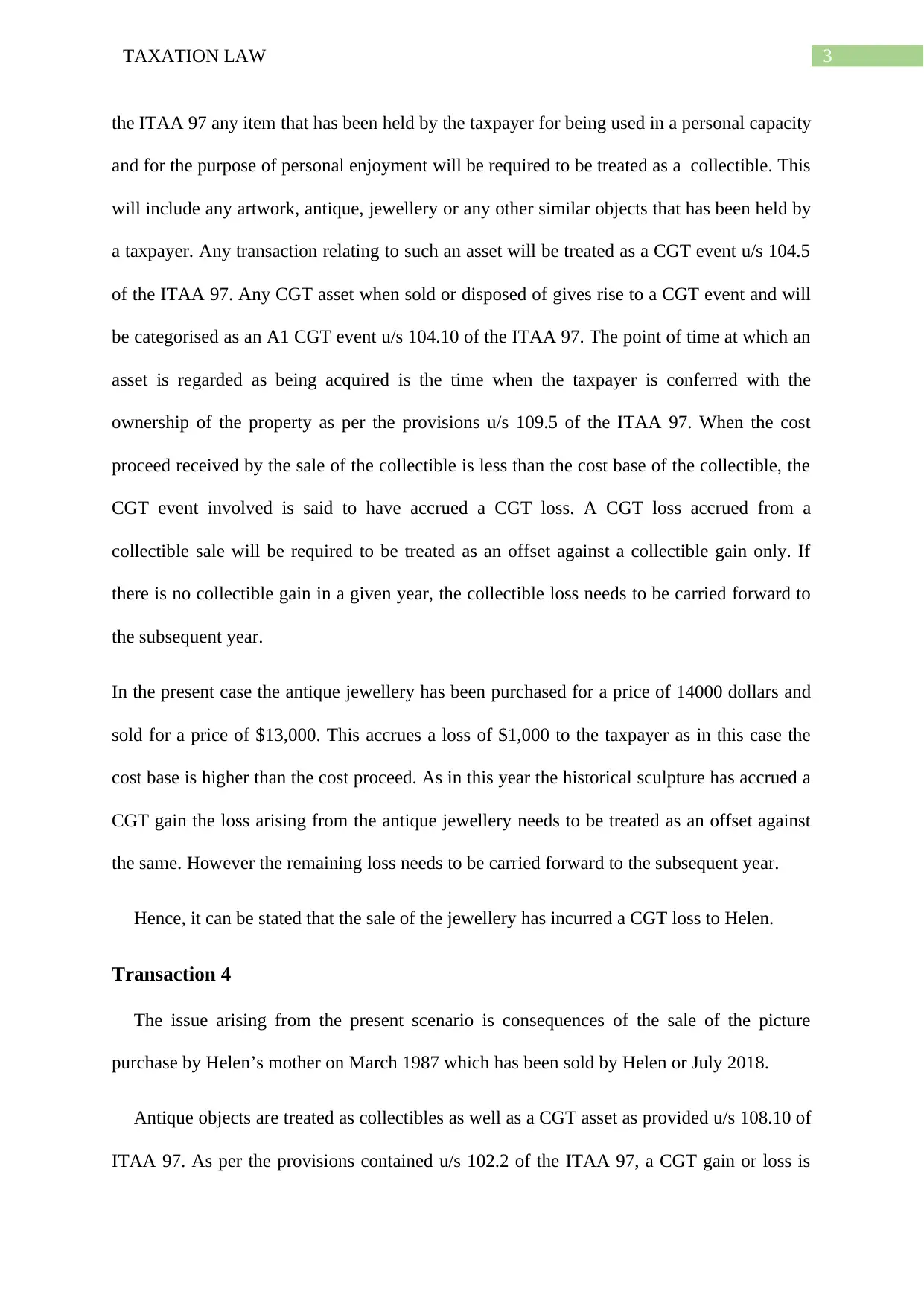
3TAXATION LAW
the ITAA 97 any item that has been held by the taxpayer for being used in a personal capacity
and for the purpose of personal enjoyment will be required to be treated as a collectible. This
will include any artwork, antique, jewellery or any other similar objects that has been held by
a taxpayer. Any transaction relating to such an asset will be treated as a CGT event u/s 104.5
of the ITAA 97. Any CGT asset when sold or disposed of gives rise to a CGT event and will
be categorised as an A1 CGT event u/s 104.10 of the ITAA 97. The point of time at which an
asset is regarded as being acquired is the time when the taxpayer is conferred with the
ownership of the property as per the provisions u/s 109.5 of the ITAA 97. When the cost
proceed received by the sale of the collectible is less than the cost base of the collectible, the
CGT event involved is said to have accrued a CGT loss. A CGT loss accrued from a
collectible sale will be required to be treated as an offset against a collectible gain only. If
there is no collectible gain in a given year, the collectible loss needs to be carried forward to
the subsequent year.
In the present case the antique jewellery has been purchased for a price of 14000 dollars and
sold for a price of $13,000. This accrues a loss of $1,000 to the taxpayer as in this case the
cost base is higher than the cost proceed. As in this year the historical sculpture has accrued a
CGT gain the loss arising from the antique jewellery needs to be treated as an offset against
the same. However the remaining loss needs to be carried forward to the subsequent year.
Hence, it can be stated that the sale of the jewellery has incurred a CGT loss to Helen.
Transaction 4
The issue arising from the present scenario is consequences of the sale of the picture
purchase by Helen’s mother on March 1987 which has been sold by Helen or July 2018.
Antique objects are treated as collectibles as well as a CGT asset as provided u/s 108.10 of
ITAA 97. As per the provisions contained u/s 102.2 of the ITAA 97, a CGT gain or loss is
the ITAA 97 any item that has been held by the taxpayer for being used in a personal capacity
and for the purpose of personal enjoyment will be required to be treated as a collectible. This
will include any artwork, antique, jewellery or any other similar objects that has been held by
a taxpayer. Any transaction relating to such an asset will be treated as a CGT event u/s 104.5
of the ITAA 97. Any CGT asset when sold or disposed of gives rise to a CGT event and will
be categorised as an A1 CGT event u/s 104.10 of the ITAA 97. The point of time at which an
asset is regarded as being acquired is the time when the taxpayer is conferred with the
ownership of the property as per the provisions u/s 109.5 of the ITAA 97. When the cost
proceed received by the sale of the collectible is less than the cost base of the collectible, the
CGT event involved is said to have accrued a CGT loss. A CGT loss accrued from a
collectible sale will be required to be treated as an offset against a collectible gain only. If
there is no collectible gain in a given year, the collectible loss needs to be carried forward to
the subsequent year.
In the present case the antique jewellery has been purchased for a price of 14000 dollars and
sold for a price of $13,000. This accrues a loss of $1,000 to the taxpayer as in this case the
cost base is higher than the cost proceed. As in this year the historical sculpture has accrued a
CGT gain the loss arising from the antique jewellery needs to be treated as an offset against
the same. However the remaining loss needs to be carried forward to the subsequent year.
Hence, it can be stated that the sale of the jewellery has incurred a CGT loss to Helen.
Transaction 4
The issue arising from the present scenario is consequences of the sale of the picture
purchase by Helen’s mother on March 1987 which has been sold by Helen or July 2018.
Antique objects are treated as collectibles as well as a CGT asset as provided u/s 108.10 of
ITAA 97. As per the provisions contained u/s 102.2 of the ITAA 97, a CGT gain or loss is
Secure Best Marks with AI Grader
Need help grading? Try our AI Grader for instant feedback on your assignments.
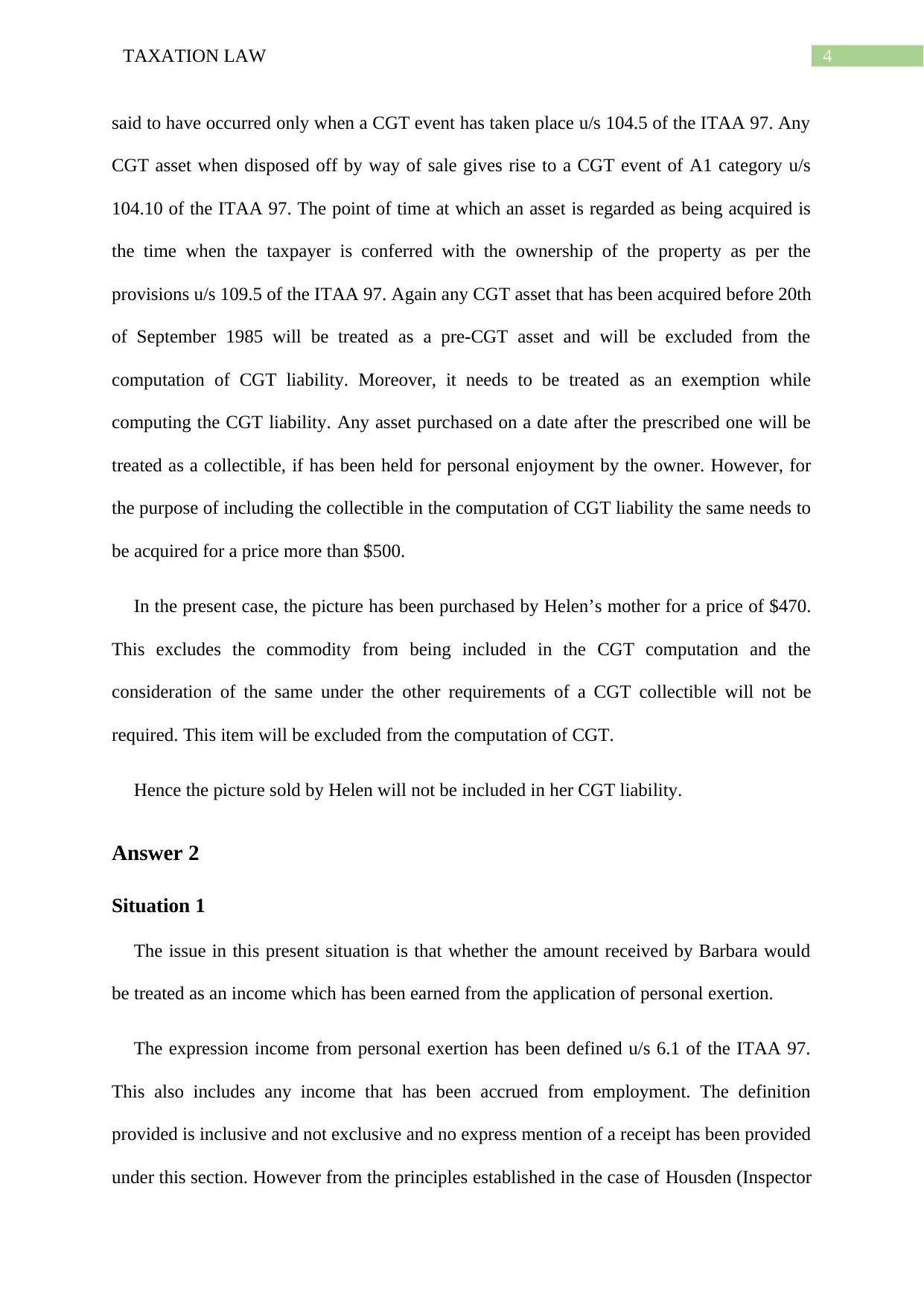
4TAXATION LAW
said to have occurred only when a CGT event has taken place u/s 104.5 of the ITAA 97. Any
CGT asset when disposed off by way of sale gives rise to a CGT event of A1 category u/s
104.10 of the ITAA 97. The point of time at which an asset is regarded as being acquired is
the time when the taxpayer is conferred with the ownership of the property as per the
provisions u/s 109.5 of the ITAA 97. Again any CGT asset that has been acquired before 20th
of September 1985 will be treated as a pre-CGT asset and will be excluded from the
computation of CGT liability. Moreover, it needs to be treated as an exemption while
computing the CGT liability. Any asset purchased on a date after the prescribed one will be
treated as a collectible, if has been held for personal enjoyment by the owner. However, for
the purpose of including the collectible in the computation of CGT liability the same needs to
be acquired for a price more than $500.
In the present case, the picture has been purchased by Helen’s mother for a price of $470.
This excludes the commodity from being included in the CGT computation and the
consideration of the same under the other requirements of a CGT collectible will not be
required. This item will be excluded from the computation of CGT.
Hence the picture sold by Helen will not be included in her CGT liability.
Answer 2
Situation 1
The issue in this present situation is that whether the amount received by Barbara would
be treated as an income which has been earned from the application of personal exertion.
The expression income from personal exertion has been defined u/s 6.1 of the ITAA 97.
This also includes any income that has been accrued from employment. The definition
provided is inclusive and not exclusive and no express mention of a receipt has been provided
under this section. However from the principles established in the case of Housden (Inspector
said to have occurred only when a CGT event has taken place u/s 104.5 of the ITAA 97. Any
CGT asset when disposed off by way of sale gives rise to a CGT event of A1 category u/s
104.10 of the ITAA 97. The point of time at which an asset is regarded as being acquired is
the time when the taxpayer is conferred with the ownership of the property as per the
provisions u/s 109.5 of the ITAA 97. Again any CGT asset that has been acquired before 20th
of September 1985 will be treated as a pre-CGT asset and will be excluded from the
computation of CGT liability. Moreover, it needs to be treated as an exemption while
computing the CGT liability. Any asset purchased on a date after the prescribed one will be
treated as a collectible, if has been held for personal enjoyment by the owner. However, for
the purpose of including the collectible in the computation of CGT liability the same needs to
be acquired for a price more than $500.
In the present case, the picture has been purchased by Helen’s mother for a price of $470.
This excludes the commodity from being included in the CGT computation and the
consideration of the same under the other requirements of a CGT collectible will not be
required. This item will be excluded from the computation of CGT.
Hence the picture sold by Helen will not be included in her CGT liability.
Answer 2
Situation 1
The issue in this present situation is that whether the amount received by Barbara would
be treated as an income which has been earned from the application of personal exertion.
The expression income from personal exertion has been defined u/s 6.1 of the ITAA 97.
This also includes any income that has been accrued from employment. The definition
provided is inclusive and not exclusive and no express mention of a receipt has been provided
under this section. However from the principles established in the case of Housden (Inspector

5TAXATION LAW
of Taxes) v Marshall (1958), it has been held that when a receipt has been accrued as a
reward will be required to be treated as a ordinary income and is an income from personal
exertion.
Any income that has been accrued to a person with respect to any labour or services that
has been rendered by him for the purpose of or with the motive of earning income will be
treated as income from personal exertion.
Copyright is treated as a Capital asset and any proceeds received from the sale of the same
is required to be treated as a capital receipt. This can be supported with the case of Federal
Commissioner of Taxation v. Whitfords Beach Pty. Ltd (1982) 150 CLR 355.
It has been held in the case of Blank v. Commissioner of Taxation [2015] FCAFC 154,
where the taxpayer has assigned the rights relating to an autobiography or a manuscript of a
book for a receipt, it needs to be treated as an assessable income in the hands of the taxpayer.
In the present case Barbara has written the book as offered by the Eco Books Ltd. It needs
to be treated as an income of from personal exertion as has been made evident from the case
of Housden (Inspector of Taxes) v Marshall (1958). Receipt of $13,000 needs to be treated as
an income from personal exertion.
Again the assigning of the copyright is required to be treated as capital receipt as has been
made evident with the case of Federal Commissioner of Taxation v. Whitfords Beach Pty.
Ltd (1982) 150 CLR 355. Hence the assigning of the copyright for a price of $13400 is
required to be treated as capital gain.
The selling of the manuscripts of the book as well as the interviews will be required to be
treated as an income from personal exertion. Hence the receipt of $4350 and $3200 required
to be treated as income from personal exertion.
of Taxes) v Marshall (1958), it has been held that when a receipt has been accrued as a
reward will be required to be treated as a ordinary income and is an income from personal
exertion.
Any income that has been accrued to a person with respect to any labour or services that
has been rendered by him for the purpose of or with the motive of earning income will be
treated as income from personal exertion.
Copyright is treated as a Capital asset and any proceeds received from the sale of the same
is required to be treated as a capital receipt. This can be supported with the case of Federal
Commissioner of Taxation v. Whitfords Beach Pty. Ltd (1982) 150 CLR 355.
It has been held in the case of Blank v. Commissioner of Taxation [2015] FCAFC 154,
where the taxpayer has assigned the rights relating to an autobiography or a manuscript of a
book for a receipt, it needs to be treated as an assessable income in the hands of the taxpayer.
In the present case Barbara has written the book as offered by the Eco Books Ltd. It needs
to be treated as an income of from personal exertion as has been made evident from the case
of Housden (Inspector of Taxes) v Marshall (1958). Receipt of $13,000 needs to be treated as
an income from personal exertion.
Again the assigning of the copyright is required to be treated as capital receipt as has been
made evident with the case of Federal Commissioner of Taxation v. Whitfords Beach Pty.
Ltd (1982) 150 CLR 355. Hence the assigning of the copyright for a price of $13400 is
required to be treated as capital gain.
The selling of the manuscripts of the book as well as the interviews will be required to be
treated as an income from personal exertion. Hence the receipt of $4350 and $3200 required
to be treated as income from personal exertion.
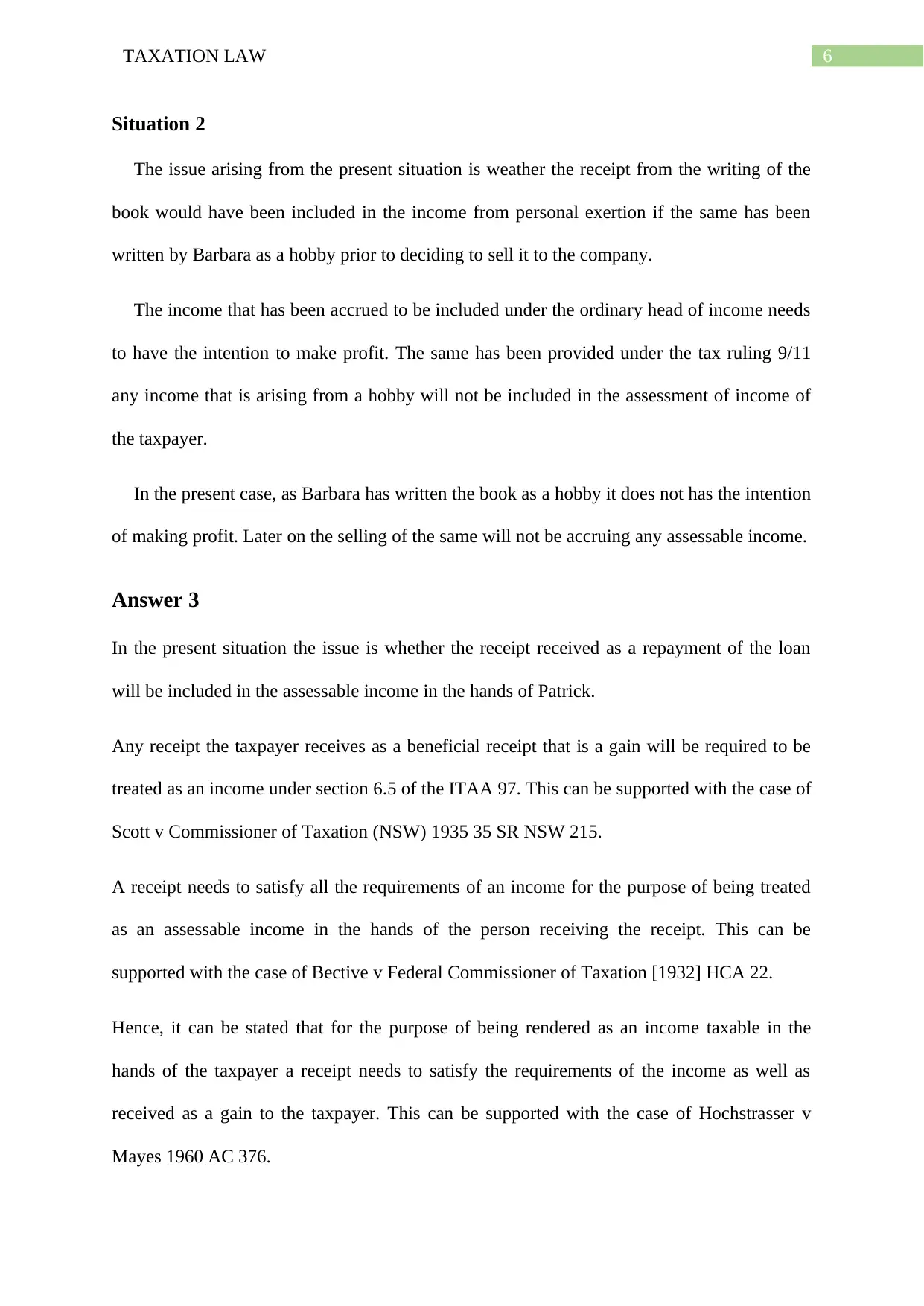
6TAXATION LAW
Situation 2
The issue arising from the present situation is weather the receipt from the writing of the
book would have been included in the income from personal exertion if the same has been
written by Barbara as a hobby prior to deciding to sell it to the company.
The income that has been accrued to be included under the ordinary head of income needs
to have the intention to make profit. The same has been provided under the tax ruling 9/11
any income that is arising from a hobby will not be included in the assessment of income of
the taxpayer.
In the present case, as Barbara has written the book as a hobby it does not has the intention
of making profit. Later on the selling of the same will not be accruing any assessable income.
Answer 3
In the present situation the issue is whether the receipt received as a repayment of the loan
will be included in the assessable income in the hands of Patrick.
Any receipt the taxpayer receives as a beneficial receipt that is a gain will be required to be
treated as an income under section 6.5 of the ITAA 97. This can be supported with the case of
Scott v Commissioner of Taxation (NSW) 1935 35 SR NSW 215.
A receipt needs to satisfy all the requirements of an income for the purpose of being treated
as an assessable income in the hands of the person receiving the receipt. This can be
supported with the case of Bective v Federal Commissioner of Taxation [1932] HCA 22.
Hence, it can be stated that for the purpose of being rendered as an income taxable in the
hands of the taxpayer a receipt needs to satisfy the requirements of the income as well as
received as a gain to the taxpayer. This can be supported with the case of Hochstrasser v
Mayes 1960 AC 376.
Situation 2
The issue arising from the present situation is weather the receipt from the writing of the
book would have been included in the income from personal exertion if the same has been
written by Barbara as a hobby prior to deciding to sell it to the company.
The income that has been accrued to be included under the ordinary head of income needs
to have the intention to make profit. The same has been provided under the tax ruling 9/11
any income that is arising from a hobby will not be included in the assessment of income of
the taxpayer.
In the present case, as Barbara has written the book as a hobby it does not has the intention
of making profit. Later on the selling of the same will not be accruing any assessable income.
Answer 3
In the present situation the issue is whether the receipt received as a repayment of the loan
will be included in the assessable income in the hands of Patrick.
Any receipt the taxpayer receives as a beneficial receipt that is a gain will be required to be
treated as an income under section 6.5 of the ITAA 97. This can be supported with the case of
Scott v Commissioner of Taxation (NSW) 1935 35 SR NSW 215.
A receipt needs to satisfy all the requirements of an income for the purpose of being treated
as an assessable income in the hands of the person receiving the receipt. This can be
supported with the case of Bective v Federal Commissioner of Taxation [1932] HCA 22.
Hence, it can be stated that for the purpose of being rendered as an income taxable in the
hands of the taxpayer a receipt needs to satisfy the requirements of the income as well as
received as a gain to the taxpayer. This can be supported with the case of Hochstrasser v
Mayes 1960 AC 376.
Paraphrase This Document
Need a fresh take? Get an instant paraphrase of this document with our AI Paraphraser

7TAXATION LAW
U/s 6.5 of the ITAA 97, can income earned through ordinary concepts will be treated as an
ordinary income.
In the present situation, a loan has been extended towards David by his father Patrick. The
amount of loan extended was $52,000. However they agreed to return amount of $58,000.no
formal agreement for the payment of interest has been made between David and Patrick.
However an additional amount of $6000 can be witnessed from the arrangement of
repayment they have made. This can be said to have accrued a gain to Patrick. Moreover at
the end of 5 years David has made a payment of additional 5% along with the loan amount.
This needs to be treated as a gain accrued to David although there has been no formal
agreement for the same.
Hence, the repayment of the loan needs to be treated as a gain as well as an assessable
income in the hands of Patrick to the extent to which it has been received as a gain.
U/s 6.5 of the ITAA 97, can income earned through ordinary concepts will be treated as an
ordinary income.
In the present situation, a loan has been extended towards David by his father Patrick. The
amount of loan extended was $52,000. However they agreed to return amount of $58,000.no
formal agreement for the payment of interest has been made between David and Patrick.
However an additional amount of $6000 can be witnessed from the arrangement of
repayment they have made. This can be said to have accrued a gain to Patrick. Moreover at
the end of 5 years David has made a payment of additional 5% along with the loan amount.
This needs to be treated as a gain accrued to David although there has been no formal
agreement for the same.
Hence, the repayment of the loan needs to be treated as a gain as well as an assessable
income in the hands of Patrick to the extent to which it has been received as a gain.

8TAXATION LAW
Reference
Bective v Federal Commissioner of Taxation [1932] HCA 22
Blank v. Commissioner of Taxation [2015] FCAFC 154
Federal Commissioner of Taxation v. Whitfords Beach Pty. Ltd (1982) 150 CLR 355
Hochstrasser v Mayes 1960 AC 376
Housden (Inspector of Taxes) v Marshall (1958)
Scott v Commissioner of Taxation (NSW) 1935 35 SR NSW 215
The Income Tax Assessment Act 1997
Reference
Bective v Federal Commissioner of Taxation [1932] HCA 22
Blank v. Commissioner of Taxation [2015] FCAFC 154
Federal Commissioner of Taxation v. Whitfords Beach Pty. Ltd (1982) 150 CLR 355
Hochstrasser v Mayes 1960 AC 376
Housden (Inspector of Taxes) v Marshall (1958)
Scott v Commissioner of Taxation (NSW) 1935 35 SR NSW 215
The Income Tax Assessment Act 1997
1 out of 9
Your All-in-One AI-Powered Toolkit for Academic Success.
+13062052269
info@desklib.com
Available 24*7 on WhatsApp / Email
![[object Object]](/_next/static/media/star-bottom.7253800d.svg)
Unlock your academic potential
© 2024 | Zucol Services PVT LTD | All rights reserved.





